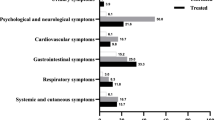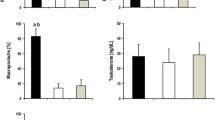Abstract
Objectives To evaluate QOL in women with microprolactinomas treated with dopamine agonists, comparing the patients with normal versus those with elevated prolactin levels, and to identify clinical and biochemical influences on patients’ QOL. Material and methods A cross-sectional evaluation was performed in two University referral centers. Fifty women with microprolactinoma answered the SF-36 questionnaire by the time of their clinical evaluation. Their biochemical analysis included PRL, estradiol, testosterone, and SHBG. Fifty women of similar age distribution served as controls. Results Patients had lower scores than controls in all SF-36 categories: physical functioning, physical role, pain, general health, vitality, social functioning, emotional aspect, and mental health. Within the patients’ group, the ones with normal PRL levels had higher scores than those with high PRL levels in all categories but the physical role. The physical functioning score correlated with the free androgen index, while the pain, vitality, social functioning, emotional aspect, and mental health scores were associated with the prolactin levels obtained at study entry. Conclusions QOL is impaired in women with microprolactinoma treated with dopamine agonists, and was inversely associated with the PRL levels. This latter finding reinforces the importance of providing adequate disease control for these patients in order to avoid the adverse consequences of hyperprolactinemia on QOL.




Similar content being viewed by others
References
Mah P, Webster J (2002) Hyperprolactinemia: etiology, diagnosis, and management. Semin Reprod Med 20:365–374 (Medline). doi:10.1055/s-2002-36709
Gillam MP, Molitch ME, Lombardi G, Colao A (2006) Advances in the treatment of prolactinomas. Endocr Rev 27:485–534 (Medline). doi:10.1210/er.2005-9998
Ciconelli RM, Ferraz MB, Santos W, Meinão I, Quaresma MR (1999) Tradução para a língua portuguesa e validação do questionário genérico de avaliação de qualidade de vida SF-36 (Brasil SF-36). Rev Bras Reumatol 39:143–150
Johnson MD, Woodburn CJ, Vance ML (2003) Quality of life in patients with a pituitary adenoma. Pituitary 6:81–87 (Medline). doi:10.1023/B:PITU.0000004798.27230.ed
Van Aken MO, Pereira AM, Biermasz NR et al (2005) Quality of life in patients after long-term biochemical cure of Cushing’s disease. J Clin Endocrinol Metab 90:3279–3286 (Medline). doi:10.1210/jc.2004-1375
Dekkers O, Van der Klaauw A, Pereira A et al (2006) Quality of life is decreased after treatment for non-functioning pituitary microadenoma. J Clin Endocrinol Metab 91:3364–3369 (Medline). doi:10.1210/jc.2006-0003
Peace KA, Orme SM, Sebastian JP et al (1997) The effect of treatment variables on mood and social adjustment in adult patients with pituitary disease. Clin Endocrinol (Oxf) 46:445–450 (Medline). doi:10.1046/j.1365-2265.1997.1600971.x
Carmines EG, Zeller RA (eds) (1990) Reliability and validity assessment. Sage University, Newbury Park
Colao A, Loche S, Cappa M et al (1998) Prolactinomas in children and adolescents. Clinical presentation and long-term follow-up. J Clin Endocrinol Metab 83:2777–2780 (Medline). doi:10.1210/jc.83.8.2777
Naliato ECO, Farias MLF, Braucks GR, Costa FSR, Zylberberg D, Violante AHD (2005) Prevalence of osteopenia in men with prolactinoma. J Endocrinol Invest 28:12–17 (Medline)
Sobrinho L (1998) Emotional aspects of hyperprolactinemia. Psychother Psychosom 67:133–139 (Medline). doi:10.1159/000012273
Sobrinho L (1991) Neuropsychiatry of prolactin. Bailiere’s Clin Endocrinol Metab 5:119–142
Kemmann E, Jones J (1983) Hyperprolactinemia and headaches. Am J Obstet Gynecol 145:668–671 (Medline)
Ly LP, Jimenez M, Zhuang TN, Celermajer DS, Conway AJ, Handelsman DJ (2001) A double-blind, placebo-controlled, randomized clinical trial of transdermal dihydrotestosterone gel on muscular strength, mobility, and quality of life in older men with partial androgen deficiency. J Clin Endocrinol Metab 86:4078–4088 (Medline). doi:10.1210/jc.86.9.4078
Ross JL, Roeltgen D, Feuillan P, Kushner H, Cutler GB Jr (1998) Effects of estrogen on nonverbal processing speed and motor function in girls with Turner’s syndrome. J Clin Endocrinol Metab 83:3198–3204 (Medline). doi:10.1210/jc.83.9.3198
Santoro N, Torrens J, Crawford S et al (2005) Correlates of circulating androgens in mid-life women: the study of women’s health across the nation. J Clin Endocrinol Metab 90:4836–4845 (Medline). doi:10.1210/jc.2004-2063
Dobs AS, Nguyen T, Pace C, Roberts CP (2002) Differential effects of oral estrogen versus oral estrogen-androgen replacement therapy on body composition in postmenopausal women. J Clin Endocrinol Metab 87:1509–1516 (Medline). doi:10.1210/jc.87.4.1509
Nunes MCP, Sobrinho LG, Calhaz-Jorge C, Santos MA, Mauricio JC, Sousa MFF (1980) Psychosomatic factors in patients with hyperprolactinemia and/or galactorrhea. Obstet Gynecol 55:591–595 (Medline)
Sobrinho L, Nunes M, Calhaz-Jorge C, Afonso A, Pereira M, Santos M (1984) Hyperprolactinemia in women with paternal deprivation during childhood. Obstet Gynecol 64:465–468 (Medline)
Acknowledgements
The authors thank Dr. Mauricio Tostes, PhD, from the Medical Psychology and Mental Health Unit of the HUCFF/UFRJ for his assistance on QOL evaluation. They also thank the Ministry of Education of Brazil through CAPES (Coordination of Personal Development—Post-graduation Level) for supporting this work in form of PhD and MSc scholarships for E. C. O. Naliato and A. Lamounier Filho, respectively. And thank FAPERJ (Carlos Chagas Filho Research Support Foundation of Rio de Janeiro) for supporting this work in form of a research grant.
Author information
Authors and Affiliations
Corresponding author
Rights and permissions
About this article
Cite this article
Cesar de Oliveira Naliato, E., Dutra Violante, A.H., Caldas, D. et al. Quality of life in women with microprolactinoma treated with dopamine agonists. Pituitary 11, 247–254 (2008). https://doi.org/10.1007/s11102-008-0091-9
Published:
Issue Date:
DOI: https://doi.org/10.1007/s11102-008-0091-9




